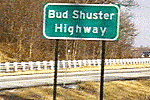A bit over a week ago the New York Times ran a piece on the recent completion of the final 18-mile leg of Interstate 99 in central Pennsylvania. I‑99 is known as the “Bud Shuster Highway” in honor of the legendary pork-barreling congressman responsible for securing the federal largess to build it. Federal budget hawks have more derisive labels for it such as “Bud Shuster’s Rollercoaster” and “The Road to Nowhere.” The latter nickname stings me personally as I grew up in Bud Shuster’s “Nowhere” district.
Nonetheless, critics of the highway who question why taxpayers in the other 49 states should pay for the powerful former House Transportation Committee Chairman’s vanity plate are correct. I recently traveled Bud Shuster’s highway for the umpteenth time over the holidays and often went a mile or two before seeing another vehicle. The fact of the matter is that had Bud Shuster not been the powerful chairman of said transportation committee, this road does not become interstate-anything.
It strikes me that I‑99 is a perfect example of what happens when politicians and bureaucrats, rather than private enterprise, are tasked with economic development. I’ll just point out three illuminating bites from the Times piece, but a google search on Bud Shuster or his highway will provide plenty more sordid details for those interested.
First, more evidence for Edwards’ Budget Law:
At $631 million, including $83 million to clean up toxic pyritic rock that was the result of a 35-million-year-old meteor impact, this section of I‑99 was nearly twice as expensive as anticipated and took at least four years longer than expected to finish.
Second, a lesson in the arrogance and disregard for the rules so commonly displayed by politicians:
…[W]hen he [Shuster] was told that the highway would officially be considered a “spur” connecting I‑76 and I‑80 and would have to be named something like Interstate 876 or Interstate 280, he resisted because, he said, it was not “catchy.” So, reaching into his childhood memories of the old rickety street car, No. 99, that took people from his hometown of Glassport, Pa., to McKeesport, he wrote into law that it would be called I‑99, believed to be the first time that was ever done. That violated the highway numbering protocol the federal government usually uses for Interstates, which requires north-south highway numbers to rise from lower in the west, like Interstate 5, to higher in the east, like Interstate 95.
Third, no need to worry about the details when taxpayers are footing the bill:
By deciding to go over the mountain, the Pennsylvania Department of Transportation cut into an acidic pyrite rock formation. The department had anticipated that, but its studies had failed to accurately calculate how much pyrite there was, and how “hot,” or acidic, it was…so acidic that when exposed to air and water, the runoff had the pH level of battery acid. The state spent two years and $83 million digging up more than one million cubic yards of the pyrite-laden rock and created a lined landfill next to the highway, mixing a larger-than-normal amount of limestone in to neutralize it and then covering it over with more fill.
Not a day goes by now that politicians and their willing accomplices don’t cry out for billions of dollars in taxpayer-financed “stimulus” to deal, in part, with “our nation’s crumbling infrastructure.” Yet, the Bud Shuster Highway provides a timely lesson on how we can expect our legislators to “invest” our money on the nation’s infrastructure. As Cato’s Chris Edwards and Peter Van Doren recently put it:
The main problem with current government infrastructure spending is not its magnitude but its lack of efficiency. More roads and transit capacity may or may not make sense depending on whether the benefits exceed the costs. One sure way to find out is to have private provision and user charges. If users are not willing to pay the costs of extra or newer capacity, then calls for taxpayer involvement probably imply subsidy of some at the expense of others rather than efficiency.

